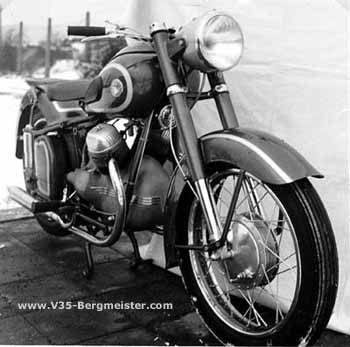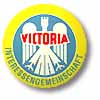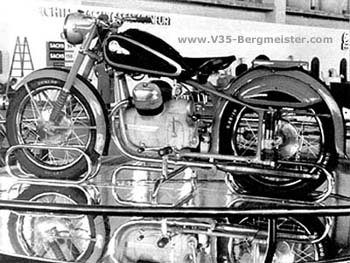|
|
 |
 |
|
The “Exotic” among the four-stroke bikes of the 50’s
(by our type specialist Manfred E. Sprenger)
|
 |
 |
|
After WW II the Victoria plants were completely destroyed by allied bombers, production slowly came up again by manufacturing small two-stroke engines from survived stock parts. In these times the foundation stone of the later motorcycle boom was layed with the 250 two stroke AERO models. But what if the Victoria riders would want a four stroke engine or, out of a sudden there is demand for a powerful sidecar bike to carry three persons comfortable without being limited to 60 kilometers per hour? The conclusion came fast, a motorcycle in the tradition of the Bergmeister models had to appear, if Victoria would not loose market share to competitors. The "economic wonder" of the fifties was about to grow, and a certain share of the customers were able to spend a higher price for a better motorcycle.
|
 |
 |
|
Prototype of the V35 Bergmeister, the foto was taken inside the VICTORIA plant, the bike still with KR26 fenders and tank as well as several pre-serial details..
Attached to the tank we notice the metal emblem of the 250 models.
Thee upper tube of the front fork is painted, during the serial production it was chrome plated. The paintwork and lining is influenced by the late KR 25 HM or the first KR 26.
|
|
 |
First ideas of the new model, that should be basically different from the competitors grew in the development department in early 1951. Victoria was bold enough to search new ways by company tradition. A man was asked for advice who did proper design jobs for Victoria before the war, and who was now running an independent design bureau in Ingolstadt together with his brother. It would not have been good old Richard Küchen, if he had no idea of an existing existing development that fits this concept very well.
A twin engine with good cooling circumstances and with the idea of a maintenance-free final drive. So what was better than a V-twin? Exactly like the one Küchen developed as a 750 cc engine for Ardie in 1938, however there was no serial production because of the war.
The idea was taken for Victoria in a 350 cc version. Together came design elements like the chain gearbox and the perfectly plain engine and gearbox housing, features Küchen was famous for and that he had realized in the Zündapp flat twin models.
It was out of question for Victoria that the new bike should proudly carry the traditional name "Bergmeister" to its type code V35.
Now they created a bike that perfectly fitted into the gap between the Horex and BMW singles and the big flat twins of Zündapp and BMW. With 2.475 DM its price was a little higher than for the competition singles, but much lower than for the boxer models.
|
|
 |
The sales figures of the Bergmeister could have been higher, if she had been a little earlier in the market. Introduced in a never produced form autumn 1951 on glossy sales prospects, with tool boxes above the rear suspension, the front fork taken from the KR 25 HM models as well as the narrow form of the fenders. Not before end of 1953 the first V35 were produced, there was a delay of two years in the sales figures. Just three years later, in 1956 they completed the last Bergmeisters in the plant. There was no proper model policy with new developments as for the pre-war boxers with the same name for the smaller sister V35.
She would have matured to an excellent bike, she really had the basis. The twin carburetor competition bikes with rear swing arm showed the way it could have been, if ... , but that's a different story to tell. Considering the long development time of the V twins, the Bergmeister does not have to hide behind the versions of Lilac, Moto Guzzi or the Honda CX models. A timeless magnificient motorcycle she is anyway.
|
|



